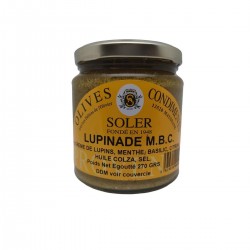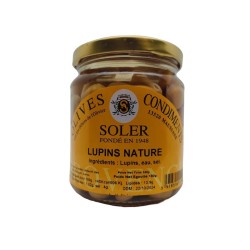
Lupin and Lupinade
Discovering Lupins in the Mediterranean
Lupins are plants found, among other places, in regions around the Mediterranean Sea.
There are many different varieties, but some are special because the seeds they produce are delicious, especially as an appetizer.
These plants have protein-rich seeds, which make them interesting.
In the Mediterranean, certain varieties of lupins are particularly appreciated, such as the Andean lupin (Lupinus mutabilis), the Narrow-leafed Blue Lupin (Lupinus angustifolius), the White Lupin (Lupinus albus), and the Yellow Lupin (Lupinus luteus).
For a long time, these lupins have been used for human and animal food, as well as for soil improvement and decorative plants.
This article invites you to discover these special lupins in the Mediterranean, highlighting their appreciated seeds, especially during a good appetizer moment.
Section 1: Lupin Seed, a Nutritional Gem for Humans
Explore the culinary diversity of lupin, a seed that goes far beyond its simple name.
Indeed, lupin is much more than a potential allergen; it is a food with multiple facets, consumed in different ways around the world.
1.1. Lupin in Human Nutrition
The lupin seed, often simply called "lupin" by metonymy, is a versatile food.
Among its variations, there are Tramousses, salted seeds of white lupin widely appreciated as an appetizer in Southern France, Spain, Portugal, the Maghreb, but also in Ecuador, Bolivia, Peru, and other regions of the world.
Let's compare the nutritional values per type of flour, expressed as a percentage of dry matter of hulled seeds.
Lupin stands out for its richness in proteins (43%), balanced lipids (12%), abundant fibers (27%), and moderate carbohydrates (13%).
This composition makes it an interesting nutritional option, especially compared to other flours such as soy and wheat flour.
Lupin, as a legume, offers varieties such as bitter yellow lupin, which requires prolonged soaking in salted water before consumption.
Long cooking is required to eliminate alkaloids, such as lupinine, present in some varieties.
However, white lupin, cultivated since antiquity in Greece, or sweet yellow lupin, has little or no alkaloids.
Today, these seeds are available in grocery stores, canned, vacuum-packed, or pickled in glass jars.
With a firm texture, less floury than other legumes, lupins can be enjoyed as an appetizer, resembling more nuts or olives than traditional legumes.
Furthermore, white lupin can be enjoyed in the form of pickled seeds called Tramousses, or as semolina for pancakes.
Organic "lupin flour," available in some stores, proves to be a versatile option in preparing various dishes.
The history of lupin consumption dates back to ancient Egypt, the Mayas, the Incas, and ancient Rome, testifying to its importance throughout the ages and cultures.
Today, four species of lupins stand out for their agronomic interest: white lupin, blue lupin, yellow lupin, and changing lupin, each contributing to human nutrition in specific regions of the world.
This protein-rich plant, adapted to European climates, represents a valuable resource in plant proteins, opening up new perspectives in the world of nutrition.
1.2. Lupin in Animal Nutrition
Lupins, three species originating from the Mediterranean basin - white lupin, yellow lupin, and blue lupin - are major players in the feed for livestock and poultry.
Their extensive cultivation attests to their importance in supplying feed for livestock.
However, it is essential to note that bitter lupins contain alkaloids that can cause neurological syndromes, similar to lathyrism.
These alkaloids can cause significant health problems, resulting in considerable losses of cattle and sheep heads in the western cordilleras of the United States each year.
In fact, all lupin varieties, whether sweet or bitter, present a potential risk of intoxication for livestock.
These intoxications, known as lupinosis, occur when the seeds are contaminated with fungi such as Phomopsis leptostromiformis or Diaporthe toxica.
These fungi produce mycotoxins, called phomopsins, which can cause liver damage in animals.
It is therefore crucial to implement prevention and control measures to avoid these intoxications and ensure the health of livestock that depend on lupins as a food source.
Section 2: Lupinade - Gourmet Creation of Délices de l'Olivier
Délices de l'Olivier has given a new life to lupin with their delicious creation, "Lupinade". This lupin cream offers a unique taste experience, especially with this mint basil lemon recipe.
2.1 Mint Basil Lemon Lupinade: A Burst of Flavors
Discover the irresistible Mint Basil Lemon Lupinade, a tasty recipe from Délices de l'Olivier.
By skillfully combining lupin cream with fresh ingredients such as mint, basil, and lemon, this Lupinade offers a burst of flavors in the mouth.
Both fresh and fragrant, this variant of Lupinade lends itself to many culinary uses.
Try it as an appetizer on buttered toast for a great start, or use it as a seasoning to enhance your vegetables, raw vegetables, meats, fish, eggs, pasta, pizza, and much more.
Prepared with care by Maison Soler - Délices de l'Olivier, this Lupinade embodies the art of combining flavors to offer a unique culinary experience with each bite.
2.2 Usage Tips: Elevate Your Dishes with Lupinade
Délices de l'Olivier shares with you tips to make the most of your Mint Basil Lemon Lupinade.
Here are some ideas to elevate your dishes:
- Appetizer: Spread Lupinade generously on buttered toast for a refined start to the meal.
- Seasoning: Use Lupinade to enhance the flavor of your vegetables, raw vegetables, meats, fish, eggs, pasta, pizza, etc.
- Culinary Creativity: Experiment by incorporating Lupinade into new recipes and discover how it can enhance each dish.
This versatile lupin cream adapts to a multitude of culinary uses, giving free rein to your creativity in the kitchen.
Délices de l'Olivier encourages you to explore the endless possibilities offered by Mint Basil Lemon Lupinade in your gastronomic daily life.
Conclusion: Lupin, a Culinary Adventure to Discover
In conclusion, delve into the fascinating world of lupin, a plant with many facets.
From seeds consumed for millennia in the Mediterranean to the gourmet creations of Délices de l'Olivier, lupin offers richness both in terms of nutrition and taste.
Explore the diversity of this legume, both on your plate and in Mint Basil Lemon Lupinade.
The usage tips invite you to unleash your culinary creativity, offering a unique culinary experience with each dish.
Whether as an appetizer with pickled lupins or in more elaborate recipes, lupin stands out as a versatile ingredient, carrying within it the heritage of an ancient food tradition.
Délices de l'Olivier has succeeded in magnifying lupin, transforming its seeds into a delicious Lupinade.
May this exploration of lupin inspire you to integrate this vegetable gem into your daily diet and discover all the flavors it has to offer.
Thank you for joining us on this culinary adventure. Enjoy your meal!



